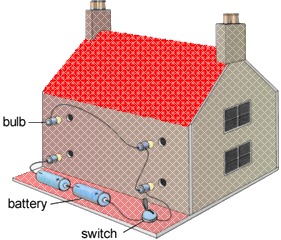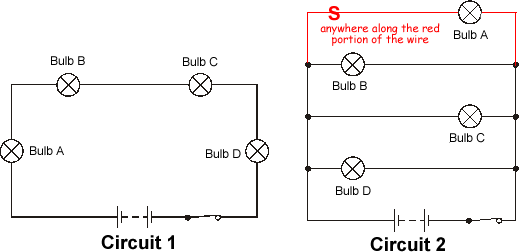Questions on Electric Circuits
Q4. Alice connects four light bulbs for her model house, as shown. She puts the bulbs into the holes in the back wall.

(a) When Alice turns the switch on, the bulbs do not light up. The batteries are not flat. None of the bulbs is broken. Why do the bulbs not light up?
There is not a complete circuit. She needs to add a wire to connect the top left bulb to the bottom left bulb. 
1 mark
(b) Alice makes the circuit work. When she turns the switch on, the bulbs are not very bright. What must Alice add to the circuit to make the bulbs brighter?
Add another electric cell to the battery  OR connect the bulbs in parallel instead of in series.
OR connect the bulbs in parallel instead of in series.
1 mark
(c) The four bulbs in the circuit are the same. Which statement is correct?
A: Each bulb is the same brightness 
B: Each bulb is of a different brightness
C: The bulbs at the top are brighter
D: The bulbs at the bottom are brighter
1 mark
The diagrams show two ways to wire the model house.

(d)
(i) In circuit 1, bulb B breaks and goes out. What happens to the other bulbs in this circuit?
They all go out 
1 mark
(ii) In circuit 2, bulb C breaks and goes out. What happens to the other bulbs in this circuit?
There is no change in their brightness, they all stay lit. 
1 mark
(e) In circuit 2, Alice adds another switch so that she can turn bulb A off while the other bulbs stay on. Write the letter 'S' on circuit 2 to show where Alice should add the switch.
The letter S must drawn onto or close to the wire in the top part of the circuit 1 anywhere between the two junctions.  (see diagram)
(see diagram)
1 mark
Maximum 6 marks


